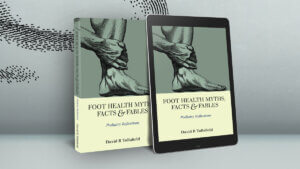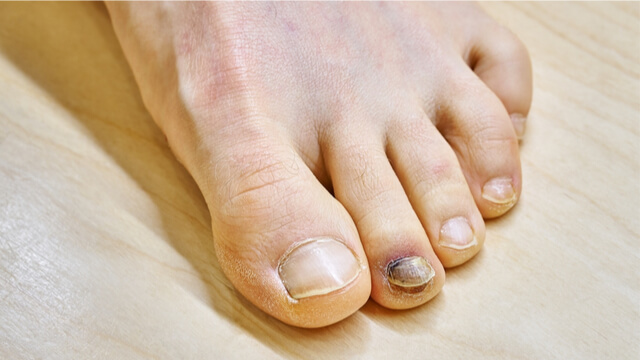Observing Good Footcare
Having a go yourself sounds a good idea and so there are two approaches to help you. What you can do to prevent the problem from arising and secondly what to do if it happens to you. Let’s start with managing the nail if a problem arises.
Managing a nail trauma
Nails take 6-9 months to grow back fully. The nail beds swell, and then change from an immature white colour to a pink colour and then appear normal. This next bit may not be for the faint-hearted but also take heart, nails do recover and life goes on.
If the nail is loose then try to remove it if you can. Don’t try and stick it back on. If however, it is separating then a compression tape may work best until the competition is over. A little local anaesthetic given by your podiatrist is easy to sort the nail out painlessly and only needs a dressing.
Nails may well make a full recovery after extensive damage but repetitive damage is going to leave some permanency. Long term and without the care required they will look like the picture below or worse!

Blood under the nail if dealt with swiftly can reduce pain and allow better recovery. The routine is to heat up a needle or end of a paper clip holding it in a way not to burn yourself. Heat this over a flame to touch the nail plate and the blood will release immediately as a spurt. The hole will close and a light dressing for 24 hours is all that is needed. If left the blood will clot and cannot be discharged although podiatrists can assist speed matters.
Read my first aid kit on this site and review how to release blood safely below…
 In this video, a U.S doctor uses a disposable heat gun. The patient is a child and no anaesthetic is used. There are other videos but some are more gruesome and this at least shows the technique works. YouTube video
In this video, a U.S doctor uses a disposable heat gun. The patient is a child and no anaesthetic is used. There are other videos but some are more gruesome and this at least shows the technique works. YouTube video
The best bits commence at 2.3 minutes for a total length of around 7+ minutes. Click over the red writing above.
Prevention
Basic care – Long nails will cause problems when the foot undergoes excessive movement. Keep the nails trimmed – but avoid cutting them too short. Make sure that you can see the free edge with a little white colour. DO NOT poke down the sides as this starts a plague of problems and damages the nail integrity.
Checklist – Press down on each nail before the sports activity and make sure there is no pre-existing pain. Check the skin around the borders and squeeze to ensure there is no discomfort or skin infection such as an ingrown toenail.
If the nail is thick, and commonly affects the little toe but can affect longer toes (eg second toe in many). Take a file (one person use only) and make short firm brushstrokes to reduce the thickness until the nail is as flat as possible.
Next check your footwear intended for the sport

Inside the shoe, there should be no rucked up material, and the inside layers, insock or insole should be in good condition.
Replace any insock available online or from shoe shops or sports shops. The inside of every shoe has an insock liner. Unless advised by a podiatrist, do not buy shoes with inlays designed to prevent pronation. It may well be that you need an inlay of some kind, but this should not be a sales technique. (Click the link inlay for advanced information)
The top material (upper) should be in good condition, not cracked across the top of the metatarsal break area (where the foot bends in the shoe). The hind part of the foot – the heel counter should not be broken down and do look inside to ensure there is no wear. Make sure the laces are not worn – replace them with a new set before your competition.

The sole and wear – modern shoes are adhered or bonded as a unit. The material will withstand normal wear but runners and sportspeople will wear the soles down depending upon activity. Central sole wear is fine as long as the tread is functional. The heel, if worn down on the outside is notable, this can push your ankle over – not ideal for any sportsperson. Change the shoes and do not try to repair them as we are talking about high-performance ability here. If the heel is worn on the inside then you have a foot problem that requires professional advice. If your heel wears down within weeks – then again seek help.
Sizing your shoe
You will need to check that the foot does not piston. Emma reported this in her own case. Tie the laces and move the shoe back and forwards. Remember there is a difference between morning and afternoon and the foot may swell. If there is a significant difference have a second, larger pair of shoes available. Always buy larger than smaller because small shoes seriously damage your foot health!
Remember when buying shoes that just because you use a size 7 from one designer, another designer may have used a different build pattern (Last) and could be a size 7.5. US and UK sizes are different. Old shoe new shoe
Fit the longest toe – often this is the second toe but it may be the first. A long toe will cause the nail and joints to impact once you start to exercise. If the shoe pistons fit a pad under the tongue of the sports shoe in felt. Cut the pad out shaped to the tongue, bevel the edges so they blend better and peel the sticky cover off and push the pad firmly in place. Before you do this check the laces and that the two facings – sides that cover the tongue, do not overlap. If they overlap this means the shoe is too big and a chance of foot pistoning will occur. The tongue pad is your first line to be a better fit, the second line of defence is an insole. Of course, if the shoe has one then you can make it thicker but you should not put multilayers in without a good adhesive bond. It is better to select a shoe that needs no additions.
The only thing left is to ensure your skin is in good health?
Use a handheld mirror under the foot to check for skin changes. Protect areas prone to blister with blister pads. These are available from pharmacies and they are thin and work well for short periods. Any blemish that is painful or gives rise to concern, have this checked by a podiatrist. Keeping the skin moist is good and there are plenty of creams on the market for regular skin. The skin remains stronger if hydrated. The internal health of the body must not be forgotten of course but such discussion is outside the boundaries of this article. Use socks that cope with sweat (NB adverts show have no association with this site).
Sweaty feet require a bit more advice so check out my article on CFP. LINK – I’m not a fan of surgical spirit and would prefer a light dusting of powder before a competition if needed.
Thanks for reading “Nail care is essential in sports” by David R Tollafield
Sign-up for here my regular FREE newsfeed
Why not read – Podiatry as a career choice? on ConsultingFootPain

You can now read Foot Health Myths Facts & Fables by David R Tollafield published at Amazon books
Published by Busypencilcase Communications Est. 2015 for ConsultingFootPain



Trackbacks/Pingbacks